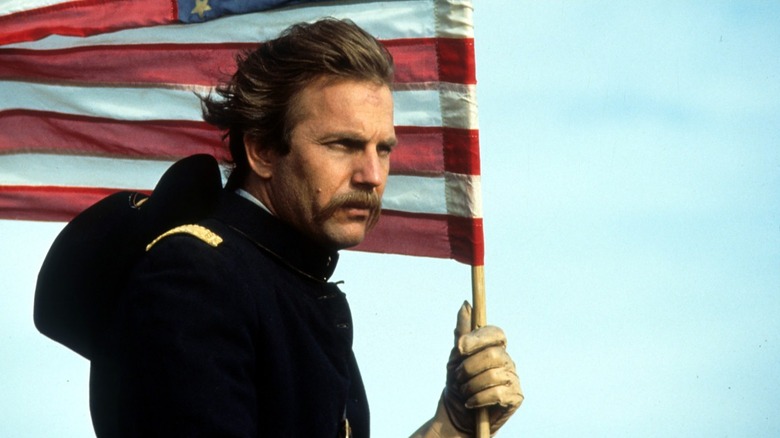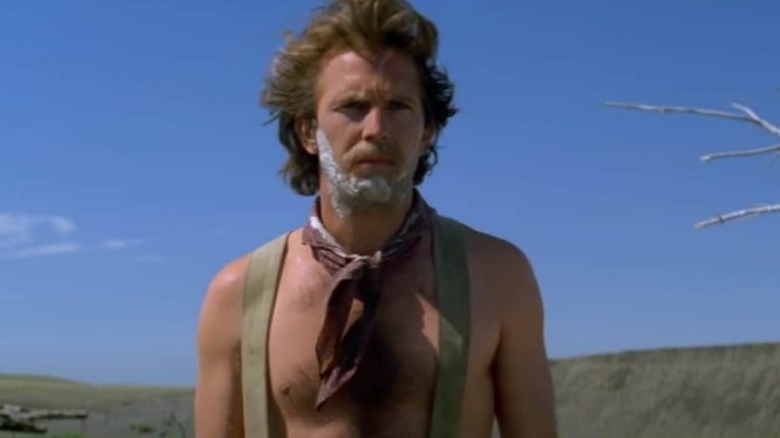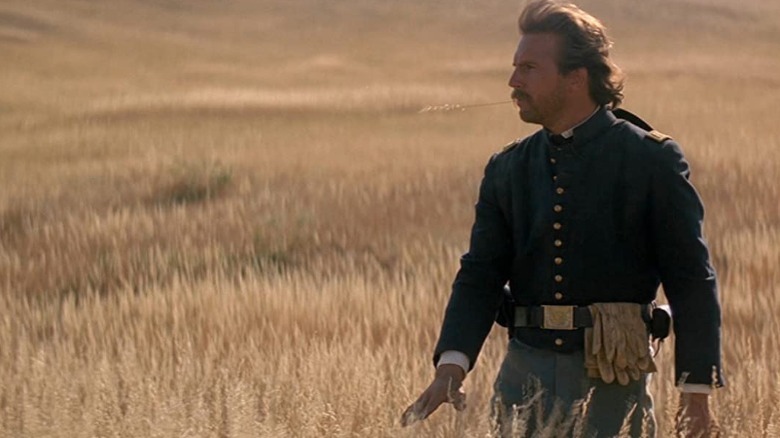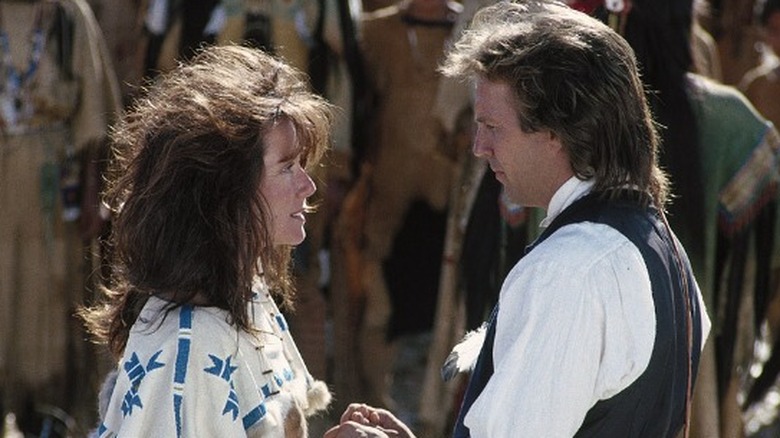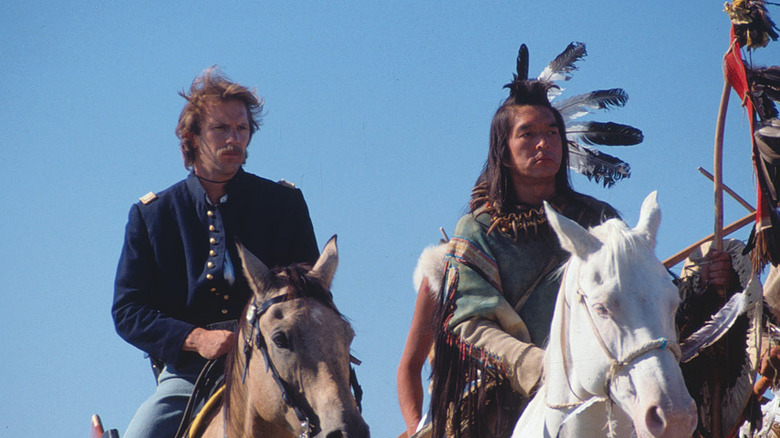Dances With Wolves Ending Explained: The New Old West
Kevin Costner's 1990 directorial debut, "Dances With Wolves," creates a new Western legend with majesty and sophistication, even as it reinforces some familiar stereotypes. It also resurrected the Western, which had been buried for over a decade. The release of Michael Cimino's 1980 immigrant saga "Heaven's Gate" — notoriously long, expensive, and demanding — had effectively killed the genre for real. According to the LA Times, industry insiders had a nickname "Dances With Wolves" prior to its release: "Kevin's Gate." With its classic status now well-established, industry skepticism around "Dances With Wolves" sounds ludicrous. But it was a gamble for Costner, who'd turned down a plum role in "The Hunt For Red October" to ensure he could produce, direct, and play the lead of this movie.
Costner made the most of the role, and turned the gamble into a massive hit. We're introduced to John Dunbar (Costner) as a wounded Union soldier on a Civil War battlefield. When he chooses a suicide run against Confederates over having his leg amputated, he strikes a messianic figure with his arms spread wide as he bounces on his horse. He survives and his battalion gains ground. As a reward, he gets the choice to be reassigned wherever he likes. He picks the frontier, as he wants to see it before it's all gone.
Duty-bound and ready to die
Dunbar's journals form the basis of a voiceover that's necessary for the man, who's quiet and taciturn, hardly willing to speak to anybody, let alone provisioner Timmons (Robert Pastorelli), Dunbar's guide and "the foulest man" he's ever met. We get a sense immediately of why Dunbar wanted to go to the frontier, as cinematographer Dean Semler crafts painterly, golden-hour images of the plains that gives the movie its spectacle. It makes the most of its widescreen imagery, just as much as Raoul Walsh's John Wayne Western "The Big Trail" did 60 years earlier.
While the film is largely quiet and intimate, the grandeur of its landscapes, with figures small on the horizon, is one of its major treasures. As if to undercut that, Timmons farts at bonfires and bugs Dunbar constantly. The two arrive at Fort Sedgwick, wrecked and abandoned, and Timmons takes off. It's not long before he's shot to death by Pawnee arrows.
Meanwhile, Dunbar takes on the arduous task of rebuilding the fort, plank by plank, slowly but surely drawing the attention of the local Sioux. They observe him from a distance and discuss him over their fires. Wind In His Hair (Rodney A. Grant) is a young, hotblooded warrior who dismisses Dunbar as a lost "fool." The tribe's holy man, Kicking Bird (Graham Greene), thinks differently, that this newly-arrived white man may be the key to their problems.
The buffalo hunt
One of the joys of "Dances With Wolves" is its easy, unhurried pace, which patiently emphasizes the difficulties of cultural exchange. If Dunbar really wants to help the Sioux and learn their ways, he needs to listen. The tribe struggles with the threat of incoming whites, the Pawnee, and a lack of buffalo. Their dialogue with Dunbar is nonverbal but generous, as he makes them bad coffee and they all try to find a common word for buffalo. Another joy is how much of the dialogue is subtitled: the actors are speaking the Lakota language, although according to Notes From the Frontier, it was incorrectly gendered.
As he arrives at their camp, Dunbar sees Stands With a Fist (Mary McDonell), a white Sioux who was taken in as a young orphan, her family killed by Pawnee. Her long-lost English is necessary, according to Kicking Bird — it will give her the chance to be an interpreter to Dunbar. Of course, they have a hard time nevertheless.
He notifies them of a buffalo herd. The buildup to and demonstration of the buffalo hunt is filmed wonderfully. A long journey, filled with disappointment and challenge, rewards the tribe once they finally find the buffalo and descend. It's epic, immersive filmmaking, and the pride on Dunbar's face shows he feels comfortable. The film may not have rewritten the rules of filmmaking like Sergio Leone's Westerns, but it cherishes its people, and the sense of community they forge. It represents a fantastical ideal of what could have been.
Nothing I've been told about these people is true
The young people in the tribe take to calling Dunbar "Loo ten tant," but the adults have their own name for him: "Dances With Wolves," after the close bond he's formed with a wolf called Two Socks. Dunbar's journal says that "the only word that came to mind was harmony," reflecting the same arc that James Cameron borrowed for his 2009 sci-fi take on the story, "Avatar." Dunbar falls in love with Stands With a Fist, and their love scene is interrupted by threats of Pawnee.
Dunbar's rifles give the Sioux the upper hand on the Pawnee in the big battle scene. While the film is notable for its compassionate and complex view of Natives as people, scenes like this, which linger on the white man's heroic murder of "bad" Indians feel passé, nor do they fight the allegations that the movie was a white savior piece.
Dunbar's heroism gives him the chance to marry Stand With a Fist. As the tribe talks of moving to their winter camp, he realizes that he needs to pick up his journal from Fort Sedgwick, or it'll leave a trail for the U.S. to follow. Dressed in Sioux wear, Dunbar's thought to be an Indian when he returns to a newly-populated Fort Sedgwick. The cavalrymen, shot at grotesque low angles, look nearly inhuman. He's beaten as he watches crows pick apart his horse, and is hardly able to defend himself.
Western reversal
In classic Hollywood, the arrival of the cavalry was signaled with bugles as they saved the day. Here, they're brutal, stupid, and ready to kill a Civil War hero. The arrival of the Sioux to rescue Dunbar is a reversal of expectations — when they emerge suddenly around the pond where Dunbar is kept, the staging is similar to the arrival of cavalry in older Wanesterns. The day is saved in the nick of time, but by Natives, who are fighting for their own.
"I don't like them, because they don't feel organic, or witty enough," said Costner of the Western genre while promoting his 2004 film "Open Range." It's easy to see why something like "Dances With Wolves" would appeal to him by comparison — its gentle pace and complex characterization of (some of) its Native characters marked it as a fundamental shift. On a $19 million budget, it made nearly $200 million domestically, showing that audiences were ready for a movie like this as well. It might not have made our Top 20 Westerns, but it succeeded financially by demonstrating heroism as well as complexity, and a bittersweet ending.
It ends not with Dunbar's rescue by Sioux, but with him volunteering to leave the tribe so as not to turn them into targets of the U.S. Army. As the epilogue notes, his plans would have been in vain anyway. In 12 years, the "last band of free Sioux submitted to white authority."
